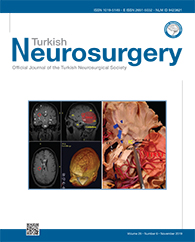MATERIAL and METHODS: We prospectively followed up a cohort of 34 patients with fractures over dural venous sinuses from January 2013 to December 2017. Twelve (35.1%) were simple depressed fractures (SDFs) and 22 (64.7%) were compound depressed fractures (CDFs). Eighteen patients (52.9%) were treated surgically, and 16 (47.1%) were treated conservatively.
RESULTS: The mean age was 20.8 years. Thirty-two of the patients were males (94.12%). The mean time from trauma until hospital arrival was 3.8 hours, and the mean admission Glasgow Coma Score (GCS) was 13.7. Direct trauma was the most common mode of injury. Funduscopy was performed in 16 patients (47.1%), and magnetic resonance venography (MRV) in four patients (11.8%). Twenty-four patients (70.59%) had the fracture overlying the superior sagittal sinus (SSS). The mean length of hospital stay was five days, and the mean follow-up duration was 6.8 months. Twenty-eight patients (82.35%) had a good recovery.
CONCLUSION: The majority of SDFs and some CDFs overlying dural sinuses can be managed safely without major surgical intervention. Conservation should be favored when the sinus is patent, dura intact, and bone displacement is insignificant in neurologically intact patients with an apparently clean wound. Otherwise, surgery should be considered. We also propose including a funduscopic examination and venogram as parts of the initial trauma work-up for these patients.
Keywords : Craniocerebral trauma, Compound depressed skull fracture, Dural sinuses injury, Simple depressed skull fracture




